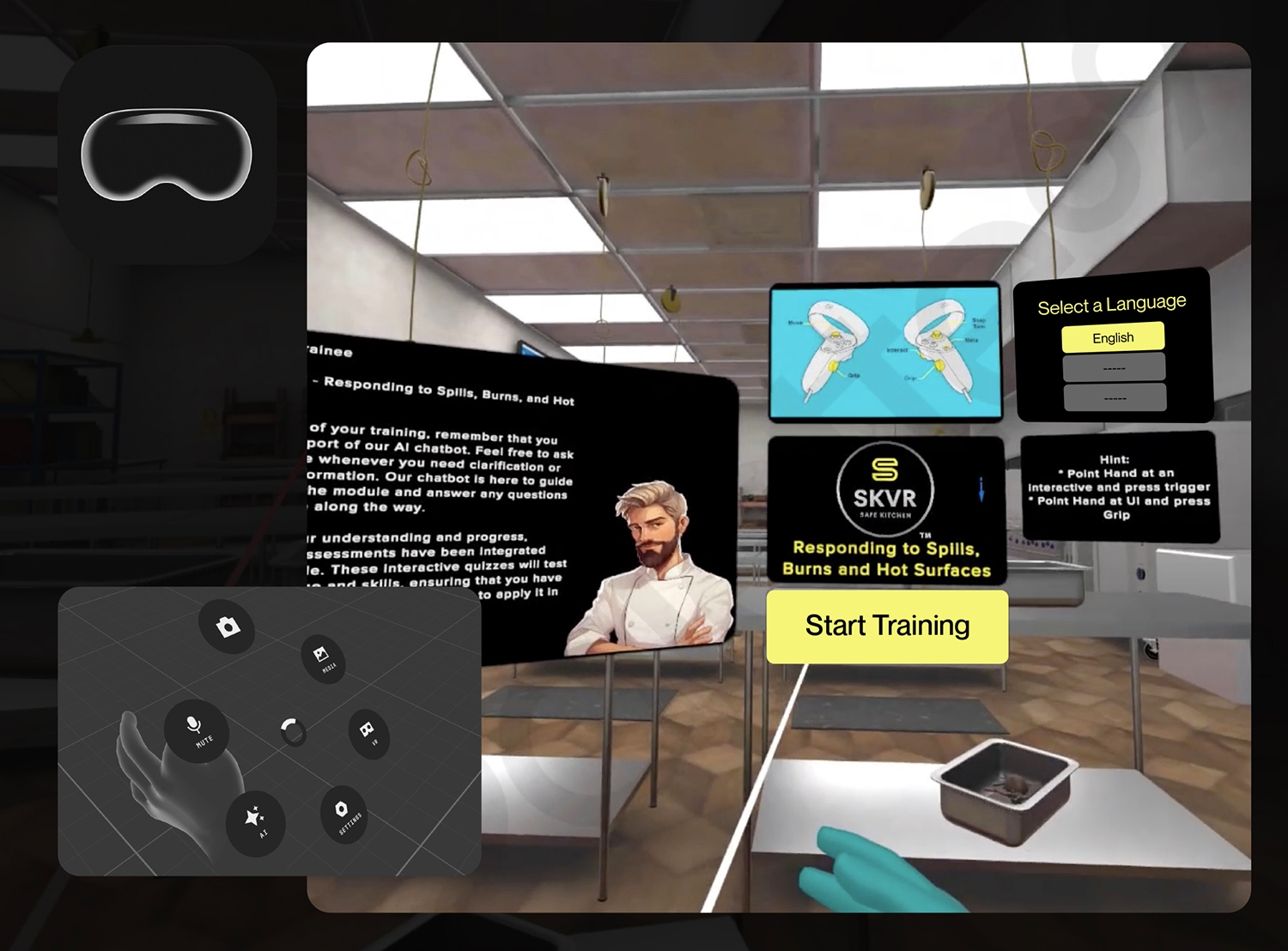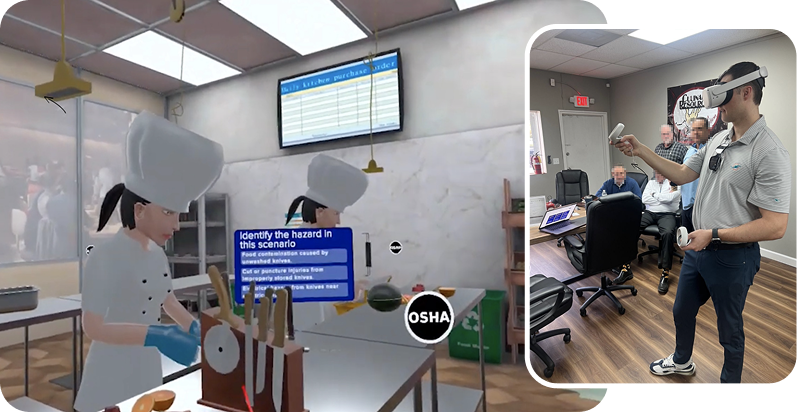case study
Case Study: VR Training Module for Kitchen Safety
Jul 17th, 2025 | 4 Mins Read

Working in a bustling commercial kitchen is exhilarating but full of risks.
In this case study, we dive into the creation of a fun and engaging VR training module aimed at teaching kitchen safety.
It covers common risks like fires, burns, cuts, slips, and falls to ensure everyone feels confident and secure while cooking.
Project Overview:
- Client: Safe Kitchen VR for Florida Technical University (*with cause verse)
- Duration: October 2023 – March 2024
- Field: VR and web-based training module

What We Set Out to Achieve
Our training module was designed with four key goals in mind:
- Spot Dangers like a Pro: We wanted kitchen staff to become experts at identifying potential hazards in commercial kitchens – from hot surfaces to wet floors and everything in between.
- Make Learning Fun and Real: Using lifelike graphics and hands-on interactive elements, we created an engaging experience that feels just like being in a real kitchen. No more boring safety manuals!
- Turn Safety into an Adventure: We added gamification elements like achievement badges, progress tracking, and friendly competitions between team members. Users earn points for spotting hazards and following safety protocols, making the whole learning experience feel like a game rather than a chore.
- Learn from Mistakes Safely: We built in smart feedback systems that let users learn from their mistakes without any real-world consequences. Every action gets instant feedback, helping users understand what they did right or wrong.
Technology Stack Used:
Web Technologies
|
Front-end Technologies
|
Project Management Tool
|
Key Benefits of VR Training for Kitchen Safety:
Our results showed just how effective VR training can be in teaching kitchen safety.
Here’s what we discovered:
Cost-Effective and Scalable Solutions:
Implementing comprehensive safety training can be costly for businesses, but our VR kitchen safety training module offers a smarter, budget-friendly solution.
With virtual environments, training can be delivered consistently across multiple locations, cutting out the need for expensive physical setups or travel.
This streamlined approach not only lowers costs but also ensures every employee receives the same high-quality training, no matter where they are.
Practice Makes Perfect (Without the Risk):
The beauty of VR is that staff can practice handling dangerous situations without any real danger.
Whether it’s dealing with grease fires or practicing knife safety, users can make mistakes and learn from them in a completely safe environment.
Instant Feedback for Real Growth:
Our real-time feedback system functions like a personal coach, offering immediate tips and corrections. Users quickly understand what they did right or wrong, making the learning process faster and more effective.
With these key benefits, our VR training module stands out as a game-changer in kitchen safety education!

FAQ Section:
- What are the safety issues with VR?
The main safety concerns with VR training involve things like motion sickness, eye strain, and the potential for trips/falls when users are immersed in a virtual environment. But these issues can be largely mitigated through proper setup, user guidance, and safety protocols. - Is VR training cheaper?
In many cases, yes! VR training can actually be more cost-effective than traditional in-person training programs. By eliminating the need for physical setups, travel, and instructor time, VR allows businesses to scale their safety training efficiently and affordably. In reference to the case study we built above, the pricing was tailored to the specific resources needed for each module, making it both affordable and high-quality, as we ensured to hire the best skill sets exactly when and where needed to achieve top-notch results. - How do I create a VR training program?
Creating a VR Training Program: Key Steps- Define Objectives: Set clear, measurable training goals.
- Plan Content: Develop a storyboard for training flow and interactivity.
- Choose Tools: Select VR development platforms (e.g., Unity) and hardware (e.g., Oculus Quest).
- Test & Refine: Conduct user testing and adjust based on feedback.
- Deploy & Monitor: Launch the program and track performance for continuous improvement
These steps ensure an effective and immersive VR training experience.
Source: How to Create VR Training Content - How effective is VR training?
VR training has been shown to be incredibly effective, as it allows trainees to practice critical skills in a realistic, risk-free environment. By simulating real-world scenarios, VR helps develop muscle memory and decision-making abilities that translate directly to the job.
Conclusion
The VR training module for kitchen safety is a game-changing solution that revolutionizes workplace safety.
By immersing staff in realistic simulations, this training helps identify hazards and empowers users to respond effectively in emergencies.
With benefits like cost-effectiveness, scalability, and risk-free learning, this VR-powered training is a must-have for any organization serious about enhancing kitchen safety.
Implement a VR training module today and elevate your team’s skills, boost morale, and run a safer, more efficient culinary operation.
Let's design a future that keeps you ahead
Request a BrainstormRecent Posts
View AllCollaborate with us
Partnership
Through strategic partnerships and collaboration, we leverage our skill set to support your team while also gaining access to your expertise, enabling us to drive impactful growth and increase revenue together.
Be our Affiliate
Refer someone who could benefit from our support, and earn a commission on any spending they make with our team.